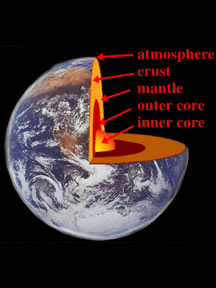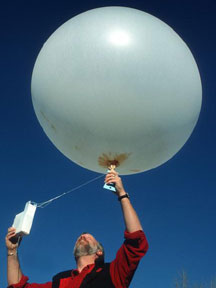Ocean waves off the coast of Mexico
Click on image for full size
copyright 2002 University Corporation for Atmospheric Research
What is a Fluid?
The short answer is that a fluid is a gas, a liquid or a
plasma.
More technically, a fluid is something which can't support a shear stress.
This sounds more complicated than it is. A shear stress is
when you try to push an object in two different directions without
squeezing it. For example, let's say that there's a pen lying on the
table in front of you with the tip pointing away from you.
Now let's say you push the tip of the pen to the left and the bottom
of the pen to the right. You've just applied a shear stress.
Now the pen is sideways (pointing to the left).
Now let's repeat this experiment with a fluid. We'll have to change
the context a bit because any fluid on our table would need to be
in a solid container to keep it from spilling or floating away. So
instead we'll consider an object out in space - how about Jupiter?
Let's imagine we're big enough to give Jupiter a shove. We can
push the top (north pole) to the left and the bottom (south pole)
to the right just like the pen. Would Jupiter turn sideways?
The answer is no, at least not in the same way as the pen.
Your hands would mostly go right through. You could move the
molecules around
but not without mixing them up. That's what
we mean when we say a fluid can't support a shear stress.
Jupiter is made of gas and a gas is a fluid.
Much of the universe is made of fluid, including planetary
atmospheres
and oceans,
stars, and
interstellar
clouds. Even rock and metal can be fluid
if they're hot enough to be molten; that's what happens
deep inside the Earth.
Fluid dynamics (also called fluid mechanics) is the science of how fluid
moves around. A fluid in motion is called a flow.
You might also be interested in:

How did life evolve on Earth? The answer to this question can help us understand our past and prepare for our future. Although evolution provides credible and reliable answers, polls show that many people turn away from science, seeking other explanations with which they are more comfortable.
...more
Earth's ocean covers more than 70% of our planet's surface. There are five major ocean basins. The Pacific Ocean is the largest. It’s so large that it covers a third of the Earth's surface. The Atlantic
...more
Earth has a diameter of approximately 12,756 km (7,972 mi). The Earth's interior consists of rock and metal. It is made up of four main layers: 1) the inner core: a solid metal core made up of nickel
...more
Liquid is one of the four common states of matter. The three others are gas, solid, and plasma. There are also some other exotic states of matter that have been discovered in recent years. A liquid does
...more
The short answer is that a fluid is a gas, a liquid or a plasma. More technically, a fluid is something which can't support a shear stress. This sounds more complicated than it is. A shear stress is when
...more
When you inflate a balloon or a tire, you are increasing the pressure on the inside of the object in order to "blow it up". Pressure is a scientific concept that applies to gases and liquids. Pressure
...more
Infrared (IR) radiation is a type of electromagnetic radiation. Infrared "light" has a longer wavelength than visible light. Red light has a longer wavelength than other colors of light, and infrared has
...more
Magnetism is a fundamental force of nature, like the force of gravity. Like gravity, which causes objects to be attracted to each other, magnetism causes magnetized objects to be attracted to each other.
...more














